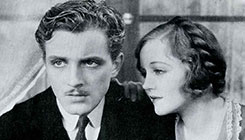|
|
|
|
The Man I Killed
|
 |
|
In his superb contribution to En tránsito: Berlin-Paris-Hollywood, the book edited for the Las
Palmas Film Festival by Carlos Losilla – an essay subsequently reprinted in LOLA – Joe McElhaney suggests of the “underrated Cluny
Brown [1946]” by Ernst Lubitsch that it “stands on the brink of two moments of
extraordinary historical transition: the moment in which it is set (June 1938,
almost exactly one year prior to the beginning of World War II) and the moment
in which it was made (late 1945, only several months after the end of the war).
It looks to the immediate past from the perspective of the war’s immediate end”.
The profundity of
this insight – and the analysis it prompts from McElhaney of the ways in which
“history in these films is at once absent and fully present” – hits home hard
during Lubitsch’s only drama, The Man I
Killed.
It is hard to
overestimate the significance and gravity of this extraordinary work.
Single-mindedly
fixed on the atrocious legacy of World War I – and the society of patriarchal
elders which sent its sons away to die, thus making that War possible – it is a
story of collective guilt, internalised by one ex-soldier from the French side,
Paul (Phillips Holmes), desperately seeking some sort of closure and
redemption.
After the sombre
introduction and contextualisation (complete with stunning and very modern
mental-image interpolations) of this premise – many, many years before the
current intellectual passion for Trauma Studies – The Man I Killed turns into something that strikingly prefigures so
many contemporary intimacy thrillers. Paul becomes the Stranger who moves in on
a family circle (the Hölderlins!) in a small German town, comprised of father
(Lionel Barrymore), mother (Louise Carter) and the dead man’s fiancé, Elsa
(Nancy Carroll).
But Paul cannot
tell the truth and reveal himself. This leads to an agonising masquerade that
inadvertently triggers a love affair with Elsa. A horrible lie, or a handy
fiction that allows the regeneration of a broken family and, in Paul himself,
the broken lullaby of his musical expression?
The Man I Killed is not devoid of
Lubitschian comedy – Elsa’s pathetic and opportunistic suitor (Lucien
Littlefield) is a familiar fop, here presented even more cruelly than usual;
and the sequences devoted to the growing love of Paul and Elsa are handled
lightly, with cutaways to every busybody in town, and a boldly musical montage
of off-screen doorbells – in descending then ascending tones – that outdoes even
the split-up syllables of Dan-i-lo in The Merry Widow (1934).
But, in general, The Man I Killed is as serious as a
heart attack, marked by a solemn poetry of accusation: Paul’s words to a Pollyanna
priest (“They call that sane – I want to be insane!”); the initial abyss between
young and old (“Millions of dead lie between us, a dead world”); and especially
Hölderlin’s declaration to his stuffy old, racist drinking companions: “Fathers
drink to the death of sons … My heart is with the young, dead or living,
everywhere, anywhere”.
And the wordless
(but richly musical) finale, moving through successive phases of hopelessness
and renewal, on a knife-edge of ambiguity all the way past the fade-out – Bill
Routt discusses it in detail here – is surely among the greatest
sequences ever made by this greatest of all filmmakers.
MORE Lubitsch: The Shop Around the Corner, Trouble in Paradise, Angel, To Be or Not to Be MORE Lubitsch (book review): How Did Lubitsch Do It? by Joseph McBride © Adrian Martin March/April 2009 |
![]()